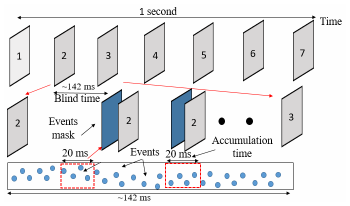
Automotive vision plays a vital role in advanced driver assistance systems (ADAS), enabling key functionalities such as collision avoidance. The effectiveness of models designed for automotive vision is typically measured based on their ability to accurately detect objects in a scene. However, an often-overlooked factor for automotive vision is the speed of the detections that depends on the data collection rate of the sensors. With conventional image sensors (CIS), the object detection rate is limited by the no information region between two consecutive frames (hereafter we refer to it as blind time), which affects the response time of drivers and ADAS to external stimuli. While increasing the CIS frame rate decreases the blind time and enables faster decision-making, it comes at the cost of increased data rate and power consumption. In contrast, lower CIS frame rates reduce data rate and have lower power consumption, but result in longer blind intervals between frames, delaying response time, which could be critical in high-risk situations. This trade-off between data rate and decision-making speed can be addressed by utilizing hybrid sensors for automotive vision. Hybrid sensors integrate event pixels alongside with CIS pixels. Event pixels provide sparse yet high-temporal-resolution data, continuously capturing changes in scene contrast that complements dense low temporal information of CIS. In this work, we demonstrate that 7fps CIS frames combined with EVS data can achieve ~40% lower data rate compared to 20fps CIS, without compromising performance of object detections. Moreover, 7fps CIS combined with EVS maintains almost constant performance within the blind time and thus enables faster detection with low data rate and power.